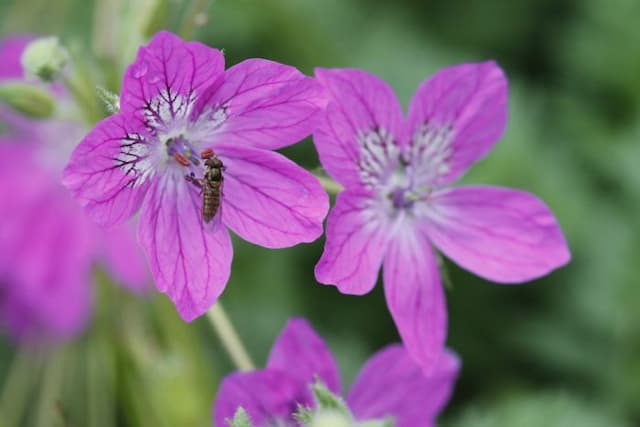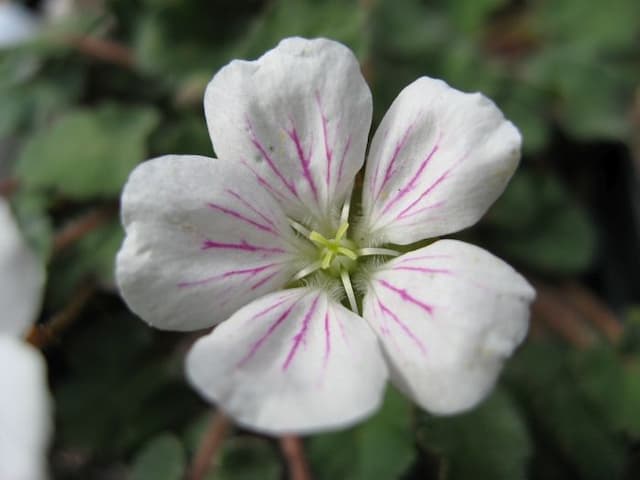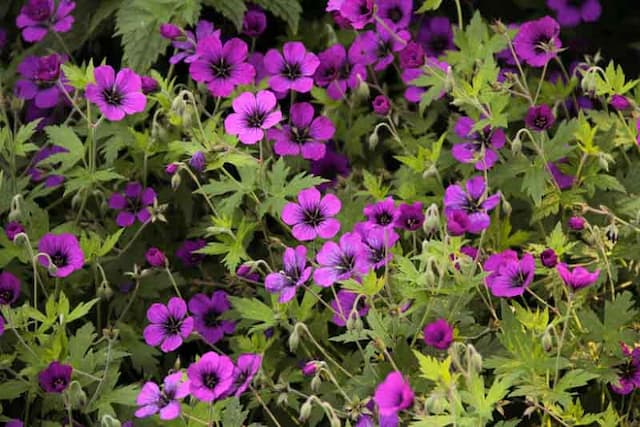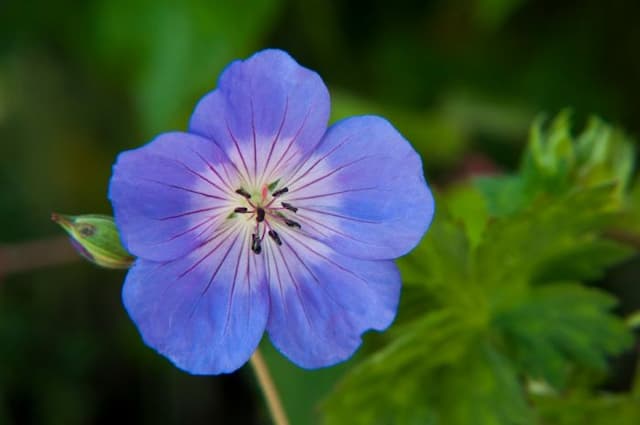Cranesbill Geranium 'Dilys'

ABOUT
Geranium 'Dilys' is characterized by its striking foliage and vibrant flowers. The leaves are typically lush green, with a unique palmately lobed shape that gives the plant a rich, textured look. Throughout the blooming season, the Geranium 'Dilys' showcases an array of flowers that are typically a magenta-pink color, with petals that feature delicate veining, giving them a marbled appearance. The blooms form in clusters and are known for their longevity, providing a showy floral display that can be a focal point in a garden setting. The overall structure of the plant is rounded, with stems that can be somewhat trailing, adding to its aesthetic appeal—making it a popular choice for both ground cover and container planting. The combination of flowers and foliage creates a contrasting palette that is both eye-catching and harmonious, attracting pollinators such as butterflies and bees to the garden.
About this plant
 Names
NamesFamily
Geraniaceae.
Synonyms
Crane's-bill, Hardy Geranium.
Common names
Geranium 'Dilys'.
 Toxicity
ToxicityTo humans
Geraniums, including the Geranium 'Dilys', are generally considered non-toxic to humans. However, they can cause mild irritation if ingested in large quantities or if the sap comes into contact with sensitive skin. The symptoms from ingestion could include nausea, vomiting, or diarrhea, but significant toxicity is rare. It's still advisable to prevent children from consuming plant parts due to the potential for stomach upset.
To pets
Geraniums are toxic to pets, particularly cats and dogs. If a pet ingests any part of a Geranium 'Dilys', they may exhibit symptoms such as vomiting, anorexia, depression, and dermatitis. In severe cases, ingestion could lead to more serious conditions like renal failure, especially in cats. Pet owners should keep these plants out of reach of their animals and monitor for any signs of distress if they suspect ingestion.
 Characteristics
CharacteristicsLife cycle
Perennials
Foliage type
Deciduous
Color of leaves
Green
Flower color
Pink
Height
2 feet (0.6 meters)
Spread
2 feet (0.6 meters)
Plant type
Herb
Hardiness zones
5
Native area
Mediterranean
Benefits
 General Benefits
General Benefits- Attractive Foliage: Geranium 'Dilys' offers deeply lobed, green leaves that add texture and contrast to garden spaces.
- Long Blooming Period: It typically has a longer flowering season, providing color from early summer to autumn.
- Wildlife Attraction: The flowers attract pollinators like bees and butterflies, supporting local ecosystems.
- Drought Tolerance: Once established, it can tolerate periods of drought, making it suitable for xeriscaping or water-wise gardens.
- Easy Propagation: It can be easily propagated by cuttings, allowing gardeners to create more plants for free.
- Low Maintenance: Requires minimal care beyond occasional watering and pruning, making it ideal for busy or novice gardeners.
- Groundcover: Its spreading habit makes it excellent for groundcover, reducing weed growth and covering bare spots.
- Versatility in Landscaping: Its size and form make it suitable for borders, rock gardens, and as underplanting for taller plants.
- Seasonal Color Variety: Offers a variety of colors depending on the cultivar, with blooms ranging from pink to purple.
 Medical Properties
Medical PropertiesThis plant is not used for medical purposes.
 Air-purifying Qualities
Air-purifying QualitiesThis plant is not specifically known for air purifying qualities.
 Other Uses
Other Uses- Geranium 'Dilys' can be used as a natural dye, where the leaves and flowers are boiled to extract a range of colors for fabric dyeing.
- The plant may serve as a companion plant in vegetable gardens, deterring certain pests while attracting beneficial insects.
- Pressing or drying the vibrant flowers of the geranium provides materials for botanical art and crafts such as card making and scrapbooking.
- The leaves of Geranium 'Dilys' can be infused in oil to create a fragrant potpourri or natural sachets for closets and drawers.
- When planted in outdoor seating areas, the scent from its foliage may create a pleasant and relaxing atmosphere.
- The Geranium 'Dilys' can be used in educational settings, like schools and botanical workshops, to teach about plant propagation and horticulture.
- Geranium 'Dilys' flowers are sometimes candied or frozen in ice cubes for an ornamental touch in culinary presentations.
- The plant can act as a natural indicator of soil health; healthy plants signify well-balanced soil while struggling plants may suggest soil deficiencies or pests.
- In photography, the distinctive flowers and foliage of Geranium 'Dilys' can be used as subjects to practice macro and nature photography skills.
- For weddings or events, the stems and flowers may be incorporated into floral arrangements, bouquets, or boutonnieres for a touch of natural elegance.
Interesting Facts
 Feng Shui
Feng ShuiThe Geranium is not used in Feng Shui practice.
 Zodiac Sign Compitability
Zodiac Sign CompitabilityThe Geranium is not used in astrology practice.
 Plant Symbolism
Plant Symbolism- Unexpected Meeting: Named after Dilys Wynne whose garden was where this hybrid was first noticed, the Geranium 'Dilys' can symbolize an unexpected but fortunate meeting, much like its serendipitous discovery.
- Friendship: Geraniums are often associated with friendship and good relationships, making the Geranium 'Dilys' a suitable gift between friends to celebrate their bond.
- Health and Healing: Geraniums in general are symbols of health and recovery; thus, Geranium 'Dilys' can represent wishes for someone's swift return to good health.
- True Geranium: Since "Geranium" is the common name for the genus, which includes many species, this symbol can emphasize authenticity and being genuine, as the Geranium 'Dilys' is a true geranium, not to be confused with Pelargoniums often called geraniums.
- Sturdiness and Perseverance: The Geranium 'Dilys' has the ability to adapt to different conditions and is quite resilient, symbolizing one's ability to endure and thrive despite adversity.
 Water
WaterThe Geranium 'Dilys', commonly known as the cranesbill geranium, requires even moisture for best growth, so it's important to water it when the top inch of soil feels dry to the touch. Generally, this means watering about once a week, but this can vary depending on environmental conditions like heat and humidity. Use a watering can or a soft spray to gently water at the base of the plant, avoiding overhead watering to prevent leaf diseases. Typically, a cranesbill geranium in a medium-sized pot will require approximately 16-24 ounces of water, ensuring that excess water is able to drain freely without waterlogging the soil. During hot summer months or in drier climates, the frequency may increase, so always check the soil before watering.
 Light
LightCranesbill geraniums, like Geranium 'Dilys', thrive in full sun to partial shade conditions. The ideal spot for this plant is in an area that receives morning sunlight and partial shade in the afternoon, which helps protect the leaves from scorching. If grown indoors, place them near a south-facing window where they can get at least 4-6 hours of sunlight daily.
 Temperature
TemperatureThe cranesbill geranium is hardy and adaptable but ideally prefers temperatures ranging from 60 to 75 degrees Fahrenheit. It can tolerate minimum temperatures down to about 25 degrees Fahrenheit but not sustained freezing conditions. They perform best when nighttime temperatures are slightly cooler than during the day, which promotes vigorous growth and flowering.
 Pruning
PruningPruning cranesbill geraniums encourages bushier growth and can help rejuvenate a plant that starts to look leggy or sparse. Trim back the plant after the initial bloom to promote a second flush of flowers. Do this by cutting the stems back by one-third immediately after the first flowering period, typically in late spring or early summer. Pruning can also be done to shape the plant as desired or to remove any dead or damaged foliage.
 Cleaning
CleaningAs needed
 Soil
SoilFor the Cranesbill (Geranium 'Dilys'), a well-draining soil mix is essential. A mixture of peat, perlite, and compost in equal parts provides the right balance. The ideal soil pH should be slightly acidic to neutral, ranging from 5.8 to 7.0.
 Repotting
RepottingCranesbills should be repotted every one to two years to refresh the soil and accommodate root growth. Geranium 'Dilys' thrives when not overpotted, so choose a container just slightly larger than the current one.
 Humidity & Misting
Humidity & MistingCranesbill geraniums are adaptable to a wide range of humidity levels but prefer moderate ambient humidity. They typically do not require any special humidity considerations.
 Suitable locations
Suitable locationsIndoor
Place in a sunny spot, well-draining soil, and water when dry.
Outdoor
Ensure full sun to part shade, enrich soil, and water regularly.
Hardiness zone
5-9 USDA
 Life cycle
Life cycleGeranium 'Dilys' begins its life as a seed, which when planted in well-drained soil and provided with sufficient warmth and moisture, will germinate and sprout into a seedling. The seedling stage is marked by the emergence of the first true leaves after the cotyledons, indicating that it is ready to start photosynthesizing. As the plant enters the vegetative stage, it grows in size and foliage, developing its characteristic deeply cut, green leaves and robust, woody stems. When mature, Geranium 'Dilys' produces magenta-pink flowers with dark veins throughout the growing season, typically from late spring to early autumn, attracting pollinators such as bees. After pollination, the flowers develop into fruit capsules containing seeds, which are eventually dispersed to give rise to new plants. As a perennial, Geranium 'Dilys' can survive for several years, dying back in winter and re-emerging from its rootstock in spring.
 Propogation
PropogationPropogation time
Spring-Summer
For the Geranium 'Dilys', propagation is most commonly achieved through stem cuttings, a method best performed in late spring or early summer. To propagate through cuttings, a healthy non-flowering shoot should be selected and cut approximately 4 inches (about 10 cm) long just below a leaf node. Lower leaves are removed, leaving two or three at the top, and the cutting is then dipped in rooting hormone to encourage root development. The prepared cutting is inserted into a pot filled with a well-draining potting mix, ensuring at least one leaf node is below the surface. The pot should be placed in bright, indirect light and kept moist but not waterlogged. Rooting typically occurs within a few weeks, followed by new growth, indicating successful propagation.







![Cranesbill [Rothbury Gem]](/_next/image?url=https%3A%2F%2Fplants-admin.emdemapps.com%2Fimages%2Fplants%2F%2Fimages%2F604b6243984c2.png&w=640&q=75)

